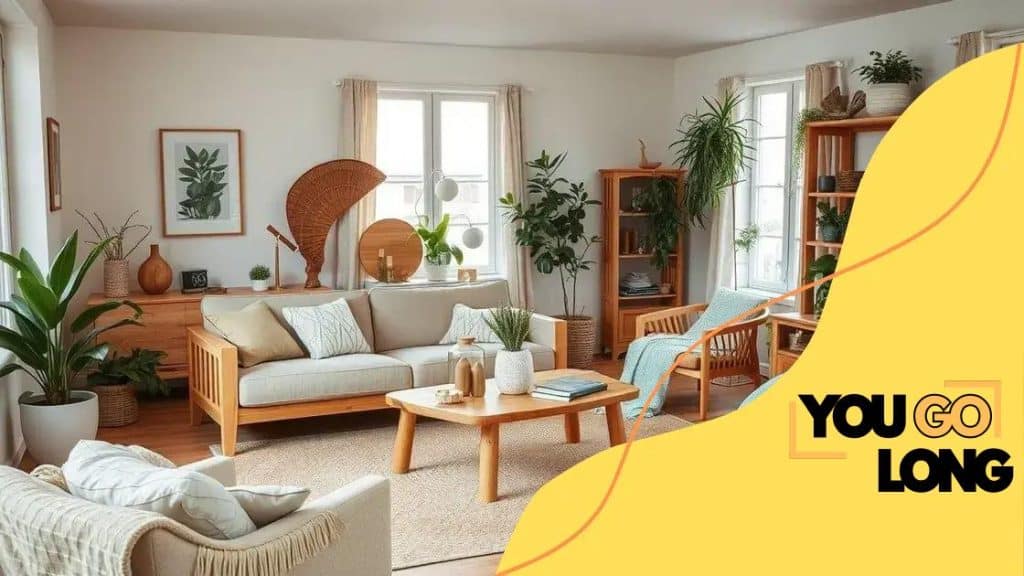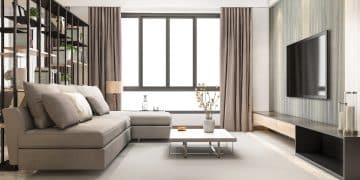How to decorate your home with eco-friendly materials

Advertisement
To decorate your home with eco-friendly materials, choose sustainable options like non-toxic paints, reclaimed wood, and natural fabrics, while incorporating plants for enhanced aesthetics and improved air quality.
How to decorate your home with eco-friendly materials is a question many of us are asking today. With growing awareness about sustainability, transforming our living spaces using eco-friendly materials not only enhances aesthetics but also contributes to a healthier planet. Ready to explore some ideas?
Understanding eco-friendly materials for home decoration
Understanding eco-friendly materials for home decoration is essential for creating a sustainable living space. These materials not only enhance the beauty of your home but also help protect the environment. By choosing wisely, you can ensure your decoration choices support healthier homes and ecosystems.
Types of Eco-Friendly Materials
There are various kinds of eco-friendly materials that you can use. These options cater to different tastes and styles, making it easy to find the right fit for your home.
Advertisement
- Bamboo: A fast-growing plant that is durable and versatile.
- Reclaimed wood: Offers character while reducing waste.
- Natural textiles: Such as organic cotton or hemp, are safe for both you and the environment.
- Low-VOC paints: These paints reduce toxic emissions and promote indoor air quality.
Using these materials can create a unique style while ensuring you are making responsible decisions. Incorporating eco-friendly materials tells a story of care for both aesthetics and the planet.
Benefits of Eco-Friendly Materials
Choosing eco-friendly options provides several benefits. First, they often feature less harmful chemicals, making them safer for your family. They can also improve air quality in your home, reducing respiratory problems.
Moreover, many eco-friendly materials are made from renewable resources, which helps decrease the demand for non-renewable options. The longevity of many eco-friendly products also means that you will be replacing items less frequently, saving you money in the long run.
Advertisement
When decorating your home, always consider how your choices impact the environment. The materials you select will reflect your values and commitment to sustainability.
Selecting sustainable wood and finishes
Selecting sustainable wood and finishes is a key step in decorating your home while being environmentally responsible. Many people are unaware that the type of wood you choose can significantly impact the planet. By understanding where your wood comes from, you can make a positive environmental choice.
Types of Sustainable Wood
There are several types of sustainable wood that you can use in your home. Each type offers unique benefits that cater to different design preferences.
- Bamboo: This fast-growing grass is renewable and can grow back quickly after harvesting.
- Reclaimed wood: Utilizing old wood reduces waste and adds character to your décor.
- FSC-certified wood: This wood comes from responsibly managed forests that ensure ecological health.
- Birch and maple: These woods are durable and often sourced sustainably, making them great choices for furniture.
When selecting wood for your home, always look for certifications indicating sustainable practices. This ensures that you are supporting environmentally-friendly harvesting and production methods.
Finishes for Sustainable Wood
The finishes you choose for your wood can also impact sustainability. Using non-toxic, low-VOC (volatile organic compounds) finishes will enhance the beauty of your wood while maintaining a healthy home.
Eco-friendly options include natural oils, water-based stains, and plant-based finishes. These products not only protect your wood but also keep harmful chemicals out of your living environment. This choice contributes to better air quality and supports your family’s health.
Being mindful of your wood and finish selections will enhance your home’s style while affirming your commitment to sustainability. Remember, every small choice can lead to a significant positive impact.
Incorporating recycled and upcycled items

Incorporating recycled and upcycled items into your home decor is a fantastic way to add style while helping the planet. These practices not only reduce waste but also bring unique character to your space. By transforming old items, you support sustainable living and can save money in the process.
What are Recycled and Upcycled Items?
Recycled items are materials that have been processed to create new products. Upcycled items, on the other hand, are old products that have been creatively repurposed for a different use without significant processing.
- Recycled materials: Include products made from paper, glass, and plastic that have been reprocessed.
- Upcycled furniture: Old chairs, tables, or dressers that have been redesigned to fit a new aesthetic.
- Textiles: Fabrics from old clothes or linens that can be transformed into cushions or quilts.
- Decorative pieces: Items from flea markets or thrift shops that can be refreshed with paint or new finishes.
By embracing these materials, you can create a truly one-of-a-kind look in your home. Each piece has a story, and incorporating them showcases your commitment to sustainability.
How to Incorporate Recycled and Upcycled Items
There are numerous ways to incorporate recycled and upcycled items into your decor. Start by visiting local thrift stores or flea markets. Look for furniture or decor pieces that catch your eye. A simple coat of paint or new upholstery can breathe life into an old item.
You can also get creative with DIY projects. For example, glass jars can become stylish plant holders, while old wooden pallets can be transformed into shelves or coffee tables. By thinking outside the box, you can turn throwaways into treasures.
Accessorizing with upcycled items is another option. Picture frames made from old wood or bottles turned into vases can add a personal touch to your home. Incorporating these elements not only enhances beauty but also promotes a valuable message about sustainability and creativity.
Choosing non-toxic paints and fabrics
Choosing non-toxic paints and fabrics is vital for creating a safe and healthy living environment. Many conventional paints and fabrics contain harmful chemicals that can affect indoor air quality and the health of your family. By opting for non-toxic varieties, you make a significant step towards a greener home.
Benefits of Non-Toxic Materials
There are several important reasons to select non-toxic options when decorating your home. These materials help maintain a safe atmosphere, promoting better health for everyone.
- Improved air quality: Non-toxic paints and fabrics release fewer volatile organic compounds (VOCs), which are harmful pollutants.
- Safe for children and pets: These materials reduce the risk of exposure to toxic substances for family members.
- Eco-friendly: Most non-toxic products are made from natural materials, making them friendlier to the environment.
- Durability: High-quality non-toxic paints and fabrics often last longer, saving you money in the long run.
Using these materials contributes to a healthier home while supporting sustainability. When you choose wisely, you create a space that nurtures both people and the planet.
Tips for Selecting Non-Toxic Options
When shopping for non-toxic paints, look for labels that highlight low or no VOC content. Brands that use natural pigments and fewer synthetic chemicals are often safer choices. Always check for certifications like Green Seal or the Greenguard label, which indicate compliance with strict environmental health standards.
For fabrics, opt for natural fibers such as organic cotton, linen, or hemp, which are less likely to be treated with harmful chemicals. Additionally, avoid synthetic blends that often contain toxic finishes. Understanding your fabric options ensures your home remains a haven.
Incorporating non-toxic paints and fabrics into your home decor not only beautifies your space but also supports a sustainable lifestyle. Every decision you make contributes to a healthier future for your family and the environment.
Creating a natural aesthetic with plants
Creating a natural aesthetic with plants can transform your home into a serene and inviting space. Plants not only enhance beauty but also improve air quality and add a sense of calm. By incorporating greenery into your decor, you foster a connection with nature, making your environment more vibrant.
Benefits of Using Plants in Home Decor
Integrating plants into your living spaces offers various benefits that go beyond decoration. They help purify the air and can even boost your mood.
- Improved air quality: Plants absorb toxins and increase humidity, leading to cleaner air.
- Enhanced mood: Being around greenery reduces stress and promotes relaxation.
- Natural beauty: Plants add color and texture, complementing any decor style.
- Easy maintenance: Many houseplants require minimal care and thrive indoors.
Incorporating plants into your home doesn’t have to be complicated. You can start by selecting a few low-maintenance varieties that suit your space and lifestyle.
Tips for Incorporating Plants
To create a cohesive look, choose plants that complement your existing decor. Large plants, like fiddle leaf figs or rubber plants, can serve as statement pieces in living areas. Smaller plants, such as succulents or pothos, work great on shelves or desks.
Consider grouping plants in various sizes and shapes to create visual interest. Using decorative pots can also elevate the look of your plants. Place them near windows to ensure they get adequate sunlight, or use grow lights in darker areas.
Hanging plants or wall-mounted planters can free up floor space and add height to your decor. Bringing plants indoors not only enhances your decor but also contributes to a healthier living environment. With thoughtful placement and care, you can easily achieve a beautiful and natural aesthetic.
FAQ – Frequently Asked Questions about Eco-Friendly Home Decorating
What are eco-friendly materials?
Eco-friendly materials are products made from sustainable resources that have a minimal impact on the environment. These include reclaimed wood, non-toxic paints, and natural textiles.
How can I incorporate plants into my home decor?
You can incorporate plants by using them as statement pieces, grouping them in various sizes, or hanging them in decorative pots to bring life to your space.
Why should I choose non-toxic paints?
Non-toxic paints reduce indoor air pollution and are safer for your family, especially children and pets. They contain fewer volatile organic compounds (VOCs).
What are the benefits of upcycling in home decor?
Upcycling allows you to creatively repurpose old items, reducing waste and giving your home a unique, personal touch while saving money.





